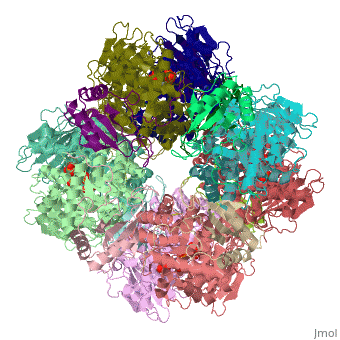Calvin cycle
See also [1]. 3 CO2 + 6 NADPH + 6 H+ + 9 ATP + 5 H2O → glyceraldehyde-3-phosphate (G3P) + 6 NADP+ + 9 ADP + 8 Pi (Pi = inorganic phosphate) (See also [2]) Step 1 The enzyme RuBisCO catalyses the carboxylation of , RuBP, a 5-carbon compound, by carbon dioxide (a total of 6 carbons) in a two-step reaction. The product of the first step is enediol-enzyme complex that can capture CO2 or O2. Thus, enediol-enzyme complex is the real carboxylase/oxygenase. The CO2 that is captured by enediol in second step produces an unstable six-carbon compound called 2-carboxy 3-keto 1,5-biphosphoribotol (CKABP) (or 3-keto-2-carboxyarabinitol 1,5-bisphosphate) that immediately splits into 2 molecules of , a 3-carbon compound. Step 2 The enzyme phosphoglycerate kinase catalyzes the phosphorylation of 3-PGA by ATP (which was produced in the light-dependent stage). (glycerate-1,3-bisphosphate) and ADP are the products. Step 3 The enzyme glyceraldehyde-3-phosphate dehydrogenase catalyzes the reduction of by NADPH (which is another product of the light-dependent stage). (also called G3P, GP, TP, PGAL, GAP) is produced, and the NADPH itself is oxidized and becomes NADP+. Again, two NADPH are utilized per CO2 fixed. This reaction is reverse to that in the glycolysis. The next stage in the Calvin cycle is to regenerate RuBP. Five G3P molecules produce three RuBP molecules, using up three molecules of ATP. Since each CO2 molecule produces two G3P molecules, three CO2 molecules produce six G3P molecules, of which five are used to regenerate RuBP, leaving a net gain of one G3P molecule per three CO2 molecules (as would be expected from the number of carbon atoms involved). The regeneration stage can be broken down into a series of steps: 1) Triose phosphate isomerase converts all of the G3P reversibly into , also a 3-carbon molecule. 2) Aldolase and fructose-1,6-bisphosphatase convert a G3P and a DHAP into (6C). A phosphate ion is lost into solution. 3)Then fixation of another CO2 generates two more G3P. 4) has two carbons removed by transketolase, giving . The two carbons on transketolase are added to a , giving the ketose .
|
| ||||||||||
